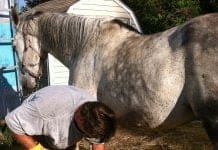I’ve used horses in the backcountry for over 20 years and attribute much of my success to my ol’ cayuses. There are times, though, that the logistics of caring for them miles from nowhere make it a daunting endeavor. One of the biggest obstacles to overcome is keeping your horse well-fed during the hunt. Miss that part and your horse suffers as do you. It’s hard to get to the deer country before first light when your mount is stopping at every wisp of grass trailside.
One of the most common questions I get is “How do you feed them and still have time to hunt?” My answer is training, training, training (the horse that is.)
A picket stake system is simply a hobble (like handcuffs but for a horse), a 3/8″ nylon rope (any Home Depot for less than $6), a stake (or tree), and a knot that you can get undone even after Ol’ Mr. Nibbles yanks on it all night. You horse has to be trained to use a picket stake at home in a safe and supervised environment.
Following is a video on the system that I use (and an additional tip for leading a pack horse.)
The knot I showed in the video wasn’t totally complete. Make two wraps around the tree or stake before tying the knot. That makes the knot even easier to get undone.
Anyone else use the picket stake? If not, what do you use?




















Good stuff Robby, using twine as a breakaway is a simple thing that makes life so much easier. When using more than one pack horse, I’ve ran a small rope between the rear cinch holes and then a piece of twine tied to that for the breakaway. Makes it easy to tie one a new piece of twine without having to go through any holes on the saddles with it cinched down tight.
For tying to my saddle horse I’ve a 1/4 ” rope run thru both rear cinch rings and an eye spliced to the front cinch ring on both the on and off side. to this I loop my twine break away. I picket my horses and the outfitters I’ve worked for by the front foot and never had a problem . I was shown & taught this by outfitters and packers who learned this from outfitters and packers from the 20’s and 30’s…They made their living with them ….
Eric, that is the first time I’ve heard of staking to a front foot. Good to hear no problems on that end too. If you have a photo of your breakaway set up, post it on here or email to me at [email protected] and I’ll post it up.
I’m away working and as soon as I get home I’ll send you a photo…Just a side note .. All the packing I’ve done or do is with the Decker Method vs. Sawbuck.
robby do you think this would work with goats. I was going to high line them but this sounds way better. iIm just starting to train them now. Thanks frank
Comments are closed.